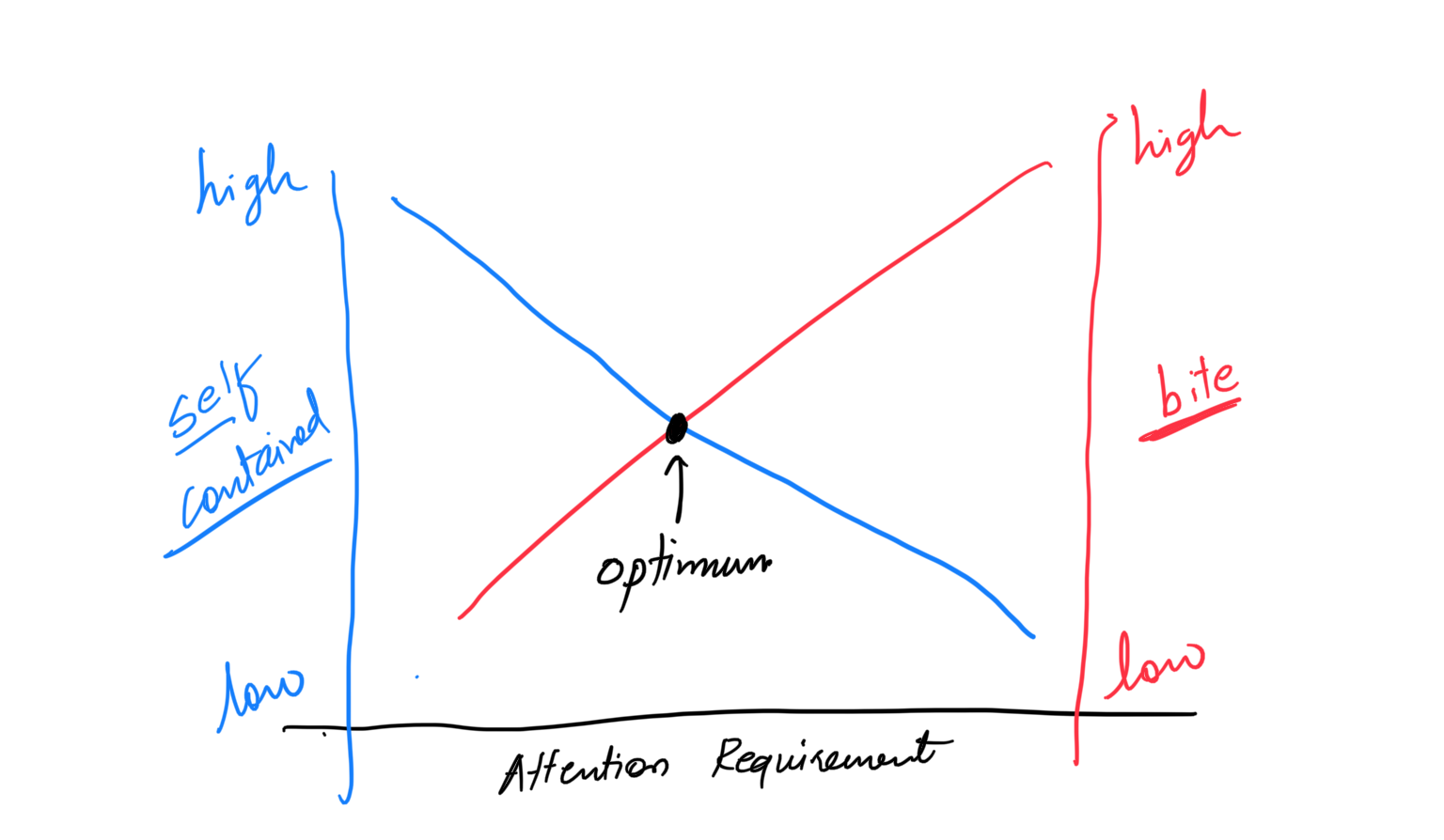Nano-modules
With ever-increasing fast access to any kind of information and a plethora of digital content presented in front of us every second,
it has become significantly easier to find something better to pay attention to in a very short amount of time, and
as a result, the human attention span has decreased significantly.
Suppose a content creator wants to deliver content with the goal of ensuring the consumer understands it. The creator is challenged to create content that can be delivered and attended to in a minuscule amount of time (only a few seconds) since they are working against one of the most expensive commodities in content delivery and consumption — human attention.
Instead of thinking of this as a challenge, there is a way to use this. Let’s think about this analytically.
We’ll call one piece of content delivered to a consumer a training module. We will consider two characteristics of a training module in this exercise.
Self-contained value of the module = how much the module depends on other training modules within the same course for content
Size of the module = how long the module is
Following is a qualitative plot of the self-contained value of training (blue, left Y-axis) vs. attention required by the consumer to comprehend the material. In the same plot, I have also plotted the size of the module (red, right Y-axis) vs. the attention required by the consumer to comprehend.
As the self-contained value of the content decreases (in other words, when the content becomes more and more dependent on the other modules in the course), the attention span required to comprehend the idea increases. If the consumer’s attention span is very low, this could become a problem.
As the size of the content decreases, the attention requirement also decreases because smaller-sized content can be consumed and understood faster. However, the material also needs to be self-contained so that it does not depend on any other content to make it understood. Delivering small content modules that depend on other small modules does not help since, in effect, you are basically delivering a large amount of content, but in small chunks.
The best way to create content is to make the material self-contained enough to fulfill the knowledge appetite and short enough to be consumed quickly. The ideal way is to create short-form, random content, which is a self-contained piece by itself, and it is also extremely difficult to do. Let’s call these modules ‘nano-modules’.
How to Make a Nano-Module Self-Contained
This is probably the most difficult part of all. Not all ideas can be delivered as self-contained ideas. Most of them depend on other ideas to understand the concept completely. One important thing a content creator can do in this situation is to make sure that the consumer understands where the nano-module fits into the big picture and which idea/concept/chapter the nano-module belongs to. If that is understood, the nano-module consumption can happen efficiently.
This requires breaking the original course down into small chapters and breaking down those chapters into smaller digestible concepts (let’s call them bites). The bites can then be broken down into nano-modules, or the bites can themselves act as nano-modules. When the nano-modules are distributed to consumers, as long as they can figure out what chapter the nano-module belongs to, they will get the whole idea. The core idea of the exercise is to make sure that consumers can zoom out of the nano-module to understand where that nano-module fits across the entire picture.
How to Make the Nano-Module Short
Various tools can be employed to deliver the nano-modules. One of the best ways to think about this is to think about how virtual experiences are designed (refer to this essay).
To draw higher engagement from the consumer, the experience creator needs to engage as many senses from the user as possible. This is the core idea behind designing a virtual experience. The more senses are engaged, the more involvement there is from the user. However, in this situation, since we want to deliver content as quickly as possible, it might be a good idea to have the user apply fewer senses. Let’s look at the various tools employed for nano-module delivery, from quickest to longest.
|
Senses Used by the User to Experience the Content |
Content Type |
Example |
Characteristics |
|
See |
Text message |
Tweet |
240 characters or less; renders directly in the browser |
|
See |
Static image with text or graphics |
Instagram post |
Fixed aspect ratio with pre-determined font size and line weights; renders directly in the browser |
|
See |
GIF image |
Tweet with a GIF or animated image sticker on messaging platforms |
Fixed aspect ratio with pre-determined font size and line and animation lengths; renders directly in the browser |
|
See and Touch |
A single question and answer |
Flashcard |
240 characters or less, flashcard animation renders directly in the browser; however, it requires a touch from the user to flip it |
|
See and Touch |
A group of static images |
Instagram post with several images |
Fixed aspect ratio with pre-determined font size and line; render directly in the browser, user input needed to flick through images |
|
Touch and Hear |
Audio file |
Podcast |
One episode = 10 minutes or less; requires an application (audio player) to run |
|
See, Touch and Hear |
Video essay |
Narration with a whiteboard illustration |
One essay = 2 mins or less; requires an application (video player) to run |
Examples
I publish a tweet each day about what I learned that day. It is an experiment I am running to deliver nano-modules, just in the form of a daily tweet. You can follow me on twitter or visit this page on my website.
I run a a data science podcast called intuitions behind Data Science where I follow the same strategy of making episodes 10 minutes of less, to explain one simple concept of data science per episode. However, even this is in my opinion is a micro module and not nano. The Instagram feed for intuitions behind Data Science leans more towards nano-content where I publish one single line of text about a particular concept of Data Science with a fixed frequency. Just by looking at that image while scrolling the Instagram feed from bottom to top will let user know about a simple concept.
There are several Instagram/TikTok creators that create really small videos of few seconds that are fun to watch, and also teach something to followers. LinkedIn Learning has started teaming up with such content creators to officially provide nano-learning content to LinkedIn Learning subscribers. Here is one collection of nano-tips for finding a job. Here is another one for learning Microsoft Excel.
One of the greatest advantages of creating nano-modules is the ability to get feedback easily. The feedback can either be active in the form of likes or comments, or it could be passive in the form measured interactions with the content. With the availability of the interaction data, a recommendation system can be built using data science techniques to deliver customised content to consumer. This would make the learning much easier, faster and tailor-made for the users.
Would love to know your thoughts!


